Trench for plumbing: standards, requirements, features of
A trench for a water supply system is a special type of soil development necessary for laying utilities - pipes for the transportation of drinking water. Despite the seeming simplicity of this task, when performing work it is necessary to follow a number of rules and regulations.
We want to talk about these rules and help you figure out how to dig a trench under the water pipe correctly.
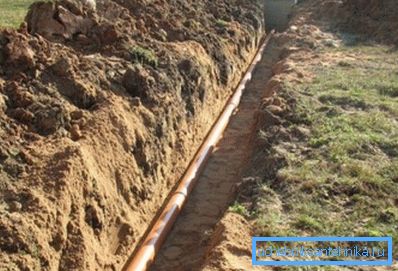
Pipeline Laying
Actual ways

Modern construction technologies assume two main methods of underground laying of water pipes:
- Laying a water pipe in a trench. In this method, prior to the installation of the pipeline, the development of the soil to the design depth, preparation of the foundation, strengthening of the trench walls is performed. After completion of laying, backfilling is performed, and the area above the work area is refined;
- Trenchless laying of water supply. This method is more progressive and involves the puncture of the soil between two technological wells, followed by the laying of the pipe into the resulting hole. Soil development, backfilling and landscaping are not required in this case.
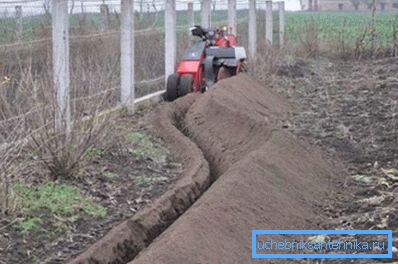
The open (trench) method of laying allows you to cope with small amounts of work with your own hands using simple tools:
- shovels
- scrap,
- perforator, etc.
It is well suited for country farms, since the soil is not covered with asphalt, the buildings are sparse, there is practically no competitive communications and infrastructure, therefore damage and subsequent restoration will be minimal.
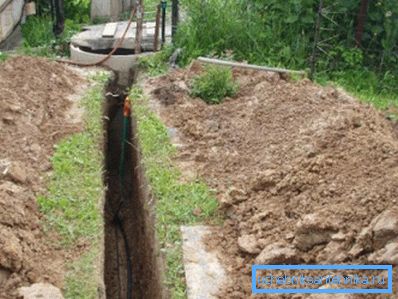
The trenchless replacement of the aqueduct, as well as its installation, require special equipment and trained workers. The method is based on horizontal directional drilling or soil puncture using special tips and a jet of water under pressure.
Excellent for urban areas with dense buildings and developed infrastructure, where the open method is sometimes not available.

Note! For arranging communications in a private sector, the open method is quite acceptable. The trenchless method is possible for overcoming highways and other similar obstacles.
Trench Development Rules
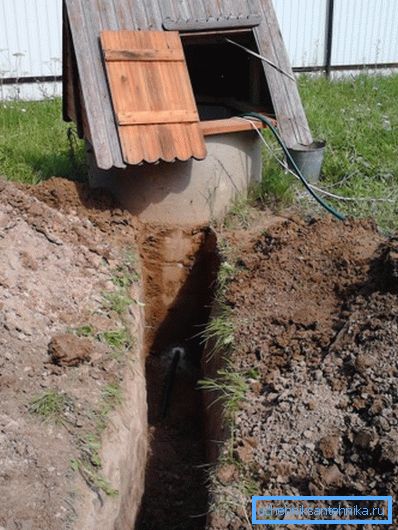
So, for work outside the city, you can use the open method of laying pipes. So we need a trench.
To construct it correctly, you will find the instruction useful, where we have collected the basic requirements and useful clarifications on a number of issues:
- It is advisable to lay a ditch along the shortest direct path. If this is not possible, it is broken into straight line segments with turns of 90 ?, other angles of turns are sometimes acceptable;
- The depth of the trench is a very important characteristic. According to SNiP, taking into account possible dynamic loads, the minimum laying depth should be at least one meter, but the climatic conditions of our country impose a different restriction: the ditch should be about 30 cm deeper than the soil freezing depth in your region (for the middle zone - approximately 2 - 3 m, for the southern regions - 1.2 - 1.3 m);
- The trench width should not be less than 70 cm when laying water pipelines for SNiP. However, in practice such strict standards are applied when working with professional services, and in the garden one can be guided by the pipe diameter and convenience of work. Usually dug to the width of a shovel - 45 - 50 cm;
- When laying water pipes, it is necessary to observe a slope of 0.002 - 0.005 in the direction of the well if there is a drain valve in it to empty the system in case of repair or preservation for the winter;
- Plumbing and sewage in one trench do not fit all the rules and regulations. However, this requirement is often ignored when using plastic pipes in protective sleeves. We would not recommend it;
- The cable and water supply system can be laid in the same trench subject to the following condition: the cable (up to 35 kV) is laid in a plastic pipe above the water supply system, the distance between them is at least 25 cm, and above the cable at least one meter of soil;
- The bottom of the trench should be tight and rammed, it is desirable that the pipe lay on the ground with a full fit body.

In addition to these rules, you will need a number of tips. So, in the northern regions and in the middle lane, it is better to cover the pipe with a layer of foam or mineral wool. Sometimes extreme frosts happen, and this measure can protect you from an accident.
When filling the ditch, especially at the initial stage (the first 25 - 30 cm), throw the ground gently into the corner of the trench. Avoid clogged lumps, bricks, stones and other heavy debris, otherwise the pipe may be damaged.

Note! Ask the locals how to dig a trench under the water supply, perhaps the price will suit you, and you can only control the process. Earthworks are not the most exciting thing to do.
The use of technology
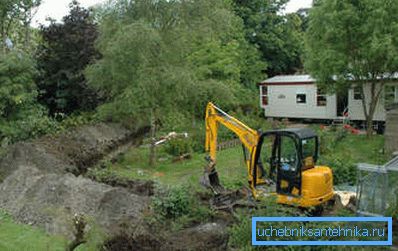
You can also help the application of technology. Today the whole mass of light mini-excavators, motoblocks and other similar good is available on the construction market. Often the rent of such a device is not so expensive, and the work is done in a matter of hours, you will not even have time to get bored.
If there is a road trench or other similar obstacle on the way, you can apply the method of puncture of the soil. To do this, from two sides of the obstacle they dig out wells half a meter deep below the depth of the gasket, and the length of the well should be one and a half to two meters. Width is about 1 - 1.2 m.
A steel pipe is cut into sections of 1 m each, at the ends of which a thread is cut. Also need couplings. A conical tip is made from one piece with a sledge hammer, at the end of which a small hole is left.
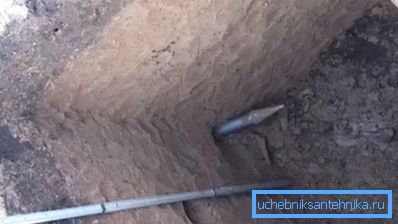
Then they take a water pump and put the hose in the well. Then the tip is driven into the ground in the direction of the second well, a pipe section is wound onto its end with the help of a coupling, a hose is inserted into the pipe and water is supplied.
A clamp or key is attached to the body of the pipe, and the pipe is pushed into the ground with the help of scrap (it should be noted that with good water pressure it goes like clockwork).
When the pipe is fully entered, the next segment is attached to it and so on until the site is completely punctured.
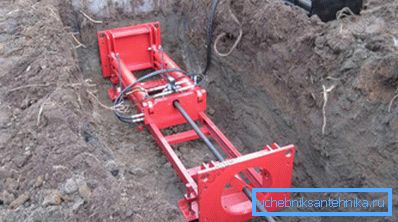
Note! To overcome the usual two-lane route will take several hours, while you do not have to restore the asphalt and block the movement.
Conclusion
Trenching is an acceptable method for laying water pipelines in rural areas. If you know the basic rules and regulations of the work, they can be done independently or with the use of technology. The video in this article will help you understand some of the nuances of the process.